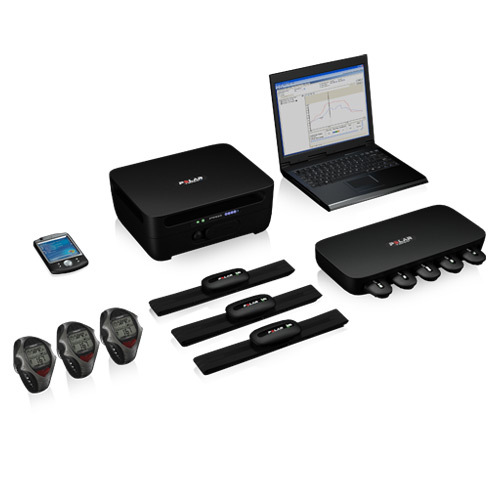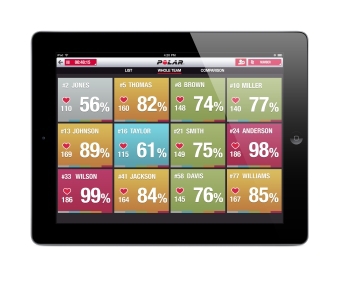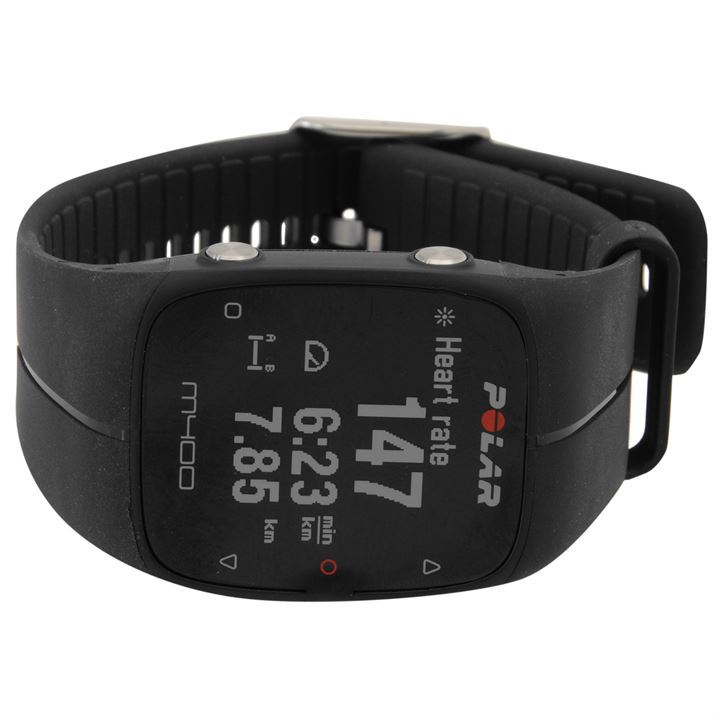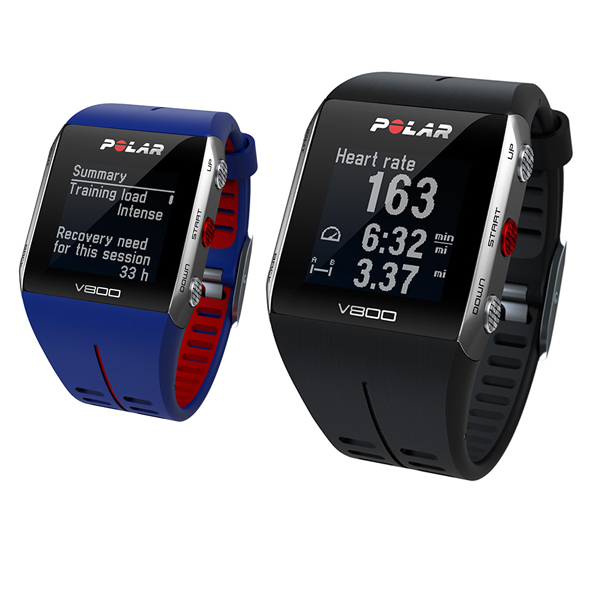Why sports need Polar
Hi Geektimes!
I think that almost everyone who leads a sports lifestyle knows about the pulsometers of the Finnish company Polar.

Other people are practically not familiar with professional heart rate monitors. And usually they think that any device that has the line “pulse measurement” in its characteristics is suitable for this.
Why some obscure Polar (Garmin, Suunto & etc.), When the Samsung Galaxy S5, S6, Gear S, Apple Watch and a bunch of different things do this? I, without any jokes, met such references even in comparative reviews. That is, the person directly wrote like this: “Garmin loses to the test participants by the fact that the sensor needs to be mounted on the chest. Which, you see, is not comme il faut . " I remember when reading that review on this phrase, myeye fell eyebrows on my forehead climbed.
After all, the nuance here is that (I immediately remembered Petka with Chapaev), that in order to measure the pulse on any of the smart watches, you have to not move, do not sweat,do not breathe and wait a couple of seconds when the treasured figure appears. Which will also be with a decent error. It is clear that for active sports - this is not an option at all.
Only chest strap sensors are suitable for measuring heart rate during active movement and in real time:

Unfortunately, we have not yet invented another (I know about Mio Alpha - this is also not an option). A detailed article on the topic "How smart watches, sports trackers and other gadgets measure heart rate?" - here .
The sports chest cardiac transmitters themselves, when assessing heart rate variability, produce highly smoothed data compared to a conventional ECG. Here is a comparison: Polar vs ECG :

But you can live and train with it. It is possible and necessary.
Returning to Polar. I am pleasantly surprised by the large number of different devices from this company. The main emphasis is on fitness, running, cyclists and swimming. But there are models for strength training (like mine - Polar FT80), and for such exotic as equestrian sport. That is, you can observe the heart rhythm of your horse. Personally, I do not have a horse. But probably it is very cool. There is also a separate product line for team sports.
Now, if, for example, take a professional cyclist. You can add to a sports watch:

What if the team? This will help the system for team sports. This is an individual heart rate monitoring for 28 people at a time.


For those who simply monitor their health, the Polar Loop fitness bracelet is a good fit. Externally, the bracelet does not attract attention and is compatible with any clothing. Unlike sports watches. The biggest plus of this bracelet is that it can work in conjunction with the Polar H6 (Bluetooth) or Polar H7 (Bluetooth + 5kHz) chest sensors. This is the main reason for buying this bracelet.

I pick up the H7 sensor in training. Both to control cardio and to more accurately calculate calories burned per workout / per day. All this is then reflected in the diary of the Polar Flow web service. Polar Loop supports this service. But my Polar FT80 sports watch, unfortunately, is not.
By the way, I recommend the Polar H7 sensor. It communicates with cardio equipment at a frequency of 5kHz. That is, for example, during training on the treadmill, the bracelet or the Polar Beat program reads the readings via Bluetooth, and the treadmill itself clings to 5kHz. Very comfortably.
Or another example: the Polar FT80 Strength Training Watch only works at 5kHz. And do not have two chest heart rate sensors. One Polar H7 is enough.
That's how I train: on one hand, a Polar FT80 watch for monitoring strength training, on the other hand a Polar Loop bracelet for monitoring daytime activity, and a Polar H7 heart rate transmitter on the chest.
Yes, I'm a Polar fan!
Among the latest models, one can note: The
heart rate monitor for monitoring the daily activity of the Polar A300 with a replaceable case:

Sports GPS watch Polar M400:

And the crown of everything and everything - sports GPS watch Polar V800:

V800 - so in general a masterpiece. The most stuffed. Yes, and cool appearance.
When the V800 went on sale, I barely resisted not to buy them. Their big minus for me was that they are very much imprisoned for running, cycling and swimming. When I need strength training. Therefore, giving almost $ 1000 for something that is not very necessary was simply not advisable. I would use their functions no more than a third. And it’s easier to sleep in a bracelet, and not with a watch. In general, they remained a dream for me.
Since the purpose of this review is only the general acquaintance of the reader with Polar products, I will not do a detailed description of the numerous equipment. This kind of stuff is already full on the Internet. I will give only links to those reviews that I liked.
Polar Loop Bracelet Review:
Polar V800 Review:
Review Polar M400:
A300 review:
As a result, after 3 years with the Polar brand, I can note:
Pros
Minuses
I do not claim to be the most experienced sports watch user. If you missed something, then supplement. The experience of others under power loads is also very interesting. What kind of electronics do you use?
For myself, I did not find the perfect product. Though climb on your kickstarter.
PS From the funny:


I think that almost everyone who leads a sports lifestyle knows about the pulsometers of the Finnish company Polar.

History of the Finnish company Polar Electro O
In 1975, the idea of creating portable cardiac monitors was born right on the ski track. In those days, there was no way to accurately measure your heart rate during exercise. Just a year later, POLAR was founded near the Finnish city of Oulu, a region known for its technological research and surrounded by some of the most difficult conditions in Europe. Specialists quickly determined that this place was the ideal base for testing the ultimate capabilities of innovative equipment of the company.
In 1979, POLAR filed its first patent application for a wireless heart rate monitor, and in 1982 it introduced to the general public the world's first wireless heart rate monitor designed to be worn, thereby permanently changing the training regimen of athletes. Now, after more than 30 years of the first wave of discoveries, POLAR offers the most extensive range of products in the industry. Starting with basic models that motivate and inform beginners and active amateur athletes who regularly engage in physical exercises, and ending with comprehensive training systems designed for world champions in various sports.
In 1979, POLAR filed its first patent application for a wireless heart rate monitor, and in 1982 it introduced to the general public the world's first wireless heart rate monitor designed to be worn, thereby permanently changing the training regimen of athletes. Now, after more than 30 years of the first wave of discoveries, POLAR offers the most extensive range of products in the industry. Starting with basic models that motivate and inform beginners and active amateur athletes who regularly engage in physical exercises, and ending with comprehensive training systems designed for world champions in various sports.
Other people are practically not familiar with professional heart rate monitors. And usually they think that any device that has the line “pulse measurement” in its characteristics is suitable for this.
Why some obscure Polar (Garmin, Suunto & etc.), When the Samsung Galaxy S5, S6, Gear S, Apple Watch and a bunch of different things do this? I, without any jokes, met such references even in comparative reviews. That is, the person directly wrote like this: “Garmin loses to the test participants by the fact that the sensor needs to be mounted on the chest. Which, you see, is not comme il faut . " I remember when reading that review on this phrase, my
After all, the nuance here is that (I immediately remembered Petka with Chapaev), that in order to measure the pulse on any of the smart watches, you have to not move, do not sweat,
Only chest strap sensors are suitable for measuring heart rate during active movement and in real time:

Unfortunately, we have not yet invented another (I know about Mio Alpha - this is also not an option). A detailed article on the topic "How smart watches, sports trackers and other gadgets measure heart rate?" - here .
The sports chest cardiac transmitters themselves, when assessing heart rate variability, produce highly smoothed data compared to a conventional ECG. Here is a comparison: Polar vs ECG :

But you can live and train with it. It is possible and necessary.
Returning to Polar. I am pleasantly surprised by the large number of different devices from this company. The main emphasis is on fitness, running, cyclists and swimming. But there are models for strength training (like mine - Polar FT80), and for such exotic as equestrian sport. That is, you can observe the heart rhythm of your horse. Personally, I do not have a horse. But probably it is very cool. There is also a separate product line for team sports.
Now, if, for example, take a professional cyclist. You can add to a sports watch:
- Cadence sensors: speed of pedals and speed of rotation of the chain.
- Mount for watches on the steering wheel.
- Keo Power Bluetooth Smart Power Meter located on the pedals. And by the way, for just over 80 thousand rubles. The irony of course. But for professional athletes, it probably matters - how they hoof the right and left foot separately.

What if the team? This will help the system for team sports. This is an individual heart rate monitoring for 28 people at a time.


For those who simply monitor their health, the Polar Loop fitness bracelet is a good fit. Externally, the bracelet does not attract attention and is compatible with any clothing. Unlike sports watches. The biggest plus of this bracelet is that it can work in conjunction with the Polar H6 (Bluetooth) or Polar H7 (Bluetooth + 5kHz) chest sensors. This is the main reason for buying this bracelet.

I pick up the H7 sensor in training. Both to control cardio and to more accurately calculate calories burned per workout / per day. All this is then reflected in the diary of the Polar Flow web service. Polar Loop supports this service. But my Polar FT80 sports watch, unfortunately, is not.
By the way, I recommend the Polar H7 sensor. It communicates with cardio equipment at a frequency of 5kHz. That is, for example, during training on the treadmill, the bracelet or the Polar Beat program reads the readings via Bluetooth, and the treadmill itself clings to 5kHz. Very comfortably.
Or another example: the Polar FT80 Strength Training Watch only works at 5kHz. And do not have two chest heart rate sensors. One Polar H7 is enough.
That's how I train: on one hand, a Polar FT80 watch for monitoring strength training, on the other hand a Polar Loop bracelet for monitoring daytime activity, and a Polar H7 heart rate transmitter on the chest.
Yes, I'm a Polar fan!
Among the latest models, one can note: The
heart rate monitor for monitoring the daily activity of the Polar A300 with a replaceable case:

Sports GPS watch Polar M400:

And the crown of everything and everything - sports GPS watch Polar V800:

V800 - so in general a masterpiece. The most stuffed. Yes, and cool appearance.
When the V800 went on sale, I barely resisted not to buy them. Their big minus for me was that they are very much imprisoned for running, cycling and swimming. When I need strength training. Therefore, giving almost $ 1000 for something that is not very necessary was simply not advisable. I would use their functions no more than a third. And it’s easier to sleep in a bracelet, and not with a watch. In general, they remained a dream for me.
Since the purpose of this review is only the general acquaintance of the reader with Polar products, I will not do a detailed description of the numerous equipment. This kind of stuff is already full on the Internet. I will give only links to those reviews that I liked.
Polar Loop Bracelet Review:
Polar V800 Review:
Review Polar M400:
A300 review:
As a result, after 3 years with the Polar brand, I can note:
Pros
- Large selection of heart rate monitors and sports watches for your tasks: running, cycling, swimming, gym, etc.
- A large number of available functions: the most accurate heart rate monitoring, calculation of calories and individual training zones, programming training according to heart rate, speed or distance. GPS support.
- Great quality materials and good looks.
- The presence of functional and convenient programs for a mobile phone.
- Web service polarpersonaltrainer.com - planning, detailed analysis of training. Plus a discussion with friends. Description here .
- Polar Flow web service - daily activity diary. The social network of Polar device owners. It shows videos of other people's trainings very effectively. That is, if some Japanese is running around his native district, I just click on its “View” icon, then I see a funny video based on Google StreetView.
Minuses
- Service polarpersonaltrainer.com - unfortunately, only in English. At first, I kind of programmed everything. But he was not able to conduct / analyze his training in it. Strongly did not like that everything is English.
- Polar Flow service - kind of like a social network. I see on the map how to train half the world. But at the same time, I just can’t find and add my real friends to my subscriptions! Who also have accounts in Polar Flow. Very big omission. For other smart bracelets, this has long been decided.
- In addition to the Polar M400, the interface of heart rate monitors and sports watches does not support Russian. Thanks at least for the fact that the Polar Flow program was translated into Russian not so long ago. Polar Beat is all the same, purely in English.
- Claim specifically to Polar Loop: lack of vibration and sound signals.
I do not claim to be the most experienced sports watch user. If you missed something, then supplement. The experience of others under power loads is also very interesting. What kind of electronics do you use?
For myself, I did not find the perfect product. Though climb on your kickstarter.
PS From the funny:


